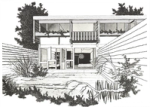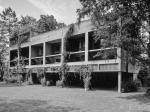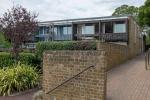From the Archive
A trip to East Croydon, via Bern, Switzerland

Sketch by Atelier 5 of St Bernards, Croydon
Part 1 — Siedlung Halen
I decided to take a couple of days off work this week. My idea of fun and recreation was a trip to East Croydon today. Yep.
A year and a half ago or so, I visited Siedlung Halen in Bern by architects Atelier 5 for my forthcoming Modernist Estates Europe book (incidentally, you can already pre-order it on Amazon, but it’s not even at the printers yet, so I feel it’s a little premature/tempting fate, but fill your boots if you are that way inclined). Anyway, I had the opportunity to meet Hans Hostettler, one of the original architects, who still lives in the Siedlung with his wife today.
As well as showing me around his home, he also told me about their project in Croydon. It’s always seemed a bit baffling that they designed a scheme there, and even though I kept meaning to, I’d never been. So anyway, today was the day. I’ll split this blog post into two parts: the first part about Halen, and the second on Croydon.
So, Halen… I’ll let Mr Hostettler tell the story:
“Mr Pini [Alfredo Pini, another of the founding members of Atelier 5] and I went on an old Lambretta to visit the farmer who owned some land outside Bern, and we asked him if we could buy a small piece of it to build five houses for ourselves. He told us it’s either all or nothing, and that was the beginning of Siedlung Halen.”
There are 78 houses in total, five of which were designed for four of the Atelier 5 architects and Niklaus Morgenthaler — Atelier 5’s engineer. They each have adjoining architects’ studios.
“Before building Halen, we built Flamatt 1 [1957–58] — a row of five prototype houses and a studio. Every architect at that time was visiting Marseille — Le Corbusier’s Unité d’habitation, and we used the exact measurements of his Modulor theory. When the houses in Flamatt were finished, we went to live in them with our families for a month — to test what was good about them and what wasn’t quite working. We realised the Modulor dimensions were very small for normal people! Mr Ernst Göhner, who was financing the Halen project, wanted us to make all the proportions a bit bigger in Halen. In the end, we changed the height to 2.30 metres, as opposed to Corb’s 2.26 metres. But everything else is the Modulor dimensions.”

Flamatt
Mr Hostettler doesn’t live in one of the five ‘atelier houses’; he lives in one at the end of a row. There are two types of layout — with a width of either 4 or 5 metres. I can’t remember which his is…
“We moved into Halen in January 1960. My family, with our two little girls aged 3 and 4. Our house is still all original; we haven’t changed anything. The kitchen is all as it was. All the other houses in Halen have updated their kitchens as families have changed, etc., and I don’t care, as long as there is one house that is exactly as we designed it. For me, it’s the best kitchen I have ever seen. It is completely practical. It was designed by a young girl who came to do an apprenticeship at Atelier 5, and she ended up working with us for 30 or 40 years — she designed every kitchen. She was a brilliant cook, and her design was completely functional. I saw her the other day; she’s in her eighties now, but I told her that my kitchen she designed is still my favourite. It’s small, but you can have two people working in it quite well.”
The houses are arranged over three floors, with the kitchen and living space on the entrance level, and two bedrooms upstairs and another bedroom downstairs.
“When we moved here, the two girls shared the bedroom downstairs, and we were upstairs. The idea was that as the children grew up, they would then move upstairs and get a bedroom each, and we moved downstairs. Now, upstairs, I use one of the rooms as my working room, and another as a guest bedroom. I also have some very simple furniture in there that I designed. In 1950–52, I worked in Paris for André Sive, and we were designing a lot of low-cost houses and furniture for the post-war population. I also worked with Jean Prouvé on the aluminium houses at Meudon at that time.”
The lower ground floor of the house opens out to a private garden.
“We spend nearly all our time in this room. Upstairs is for cooking and eating, but my wife and I love reading, so we have all our books here, and read, read, read! We also have a little shower room down here. Everything is as it was originally. It needs a little paint, but at my age, I’m not going to do anything!
Outside, there is a set of stairs that lead from the living room all the way down to the garden, so you don’t have to come through this bedroom. The design of the stairs is actually based on an old Finnish design — they usually have them in wood, but we made them in concrete here. It works very well, neither I nor my children have ever fallen off them! Outside in the garden, I have a little plant house that I designed. I got the idea for the design from a bicycle hangar.”

Next door to Halen is Thalmatt I, where I stayed in an Airbnb when I visited. It was designed 15 years after Halen and has 18 houses. There is Thalmatt II up the road, which was designed in 1985, and has 37 dwellings.
“What was amazing in the early days of Atelier 5 is that for every project we did, we would stay there, test it out, learn from it, and make the next one better. We paid particular attention to things like sound insulation, and we tweaked the design of the staircase, for example, to make the minimum amount of noise.
At the beginning of Halen, we had a very strong community. Atelier 5 were responsible for selling all the houses, so we would show clients around and talk them through everything. When people moved in, we knew everyone because of this direct contact we had had with them. Now, it’s a bit more ‘open’. Some people have died or moved away, but my wife and I hope to live out the rest of our lives here.”
Part 2 — Croydon
As I was saying in Part 1, I decided to take a long-awaited trip to Croydon to check out Atelier 5’s housing scheme St Bernards.
Again, I’ll let Mr Hostettler tell the story:
“The scheme in Croydon was the result of a competition. Wates, one of the biggest housing developers in the UK, invited us to enter. The brief was for 280* houses on a plot of land that had 300 mature trees. They stipulated that we had to retain 250 of them. So we designed the houses, with little spaces around them, with the trees and so on. We won the competition and got invited to London to present our drawings. Our meeting was at 9 am, and we presented our plans. We had all different types of houses — small ones, large ones, larger ones still, all kinds. We had to do all our drawings in UK measurements, in feet and inches! We had to learn quickly!
After an hour or two of presenting our plans to the project architect and the commercial director at Wates, the commercial man said, ‘I think there are too many houses, can you reduce it to 220* instead?’ So Anatole du Fresne and I went back to the hotel we were staying at, a room on the sixth floor of the Grosvenor Hotel in Victoria. We had brought paper and drawing materials with us, so we worked all night long, and in the morning, we presented the new larger houses. Wates were very happy with them.
There was a footpath between a smaller plot of land and a larger one, and we were to build 21 prototype houses on the smaller site first. When the slabs went down on the first 21 houses, Wates held a celebratory party. It was 1968, and it was a funny, crazy event. We had Swiss music, there were girls with Swiss flag mini skirts and a lot of Swiss cheese and cheddar, there was beer and Guinness… I heard a noise outside the tent, and I looked out and saw diggers ripping out all the mature trees on the larger plot. I asked the Wates architect what was happening, and he said Wates’ commercial director said with Atelier 5 houses they will only make 12.5% on every sale, but if they went with a standard semi-detached system, they would make 17.5%.”

St Bernards

St Bernards
So there you have it, money, money, money, eh? When I visited, I couldn’t even be bothered to have a look at what the other Wates houses looked like (it was 34 degrees to be fair). What a shame they didn’t have the guts or ambition to fully realise the scheme. So, there’s only 21 houses. I had a good look around, unfortunately, I couldn’t get into any of them though.
The houses are built on a very gradual slope as in Halen, in three rows (unlike Halen’s concrete, here the buildings are in London stock brick). The houses are over two floors — you enter on the upper floor, go through a courtyard (again like Halen) where there is apparently an eating room under a pergola, then through into the house. The living room is on the upper floor, with views across the hills, and the bedrooms are on the lower floor. There is also a back garden that is accessed through the bedroom. Standing back from the houses, you realise just how deep the plan is, I did spot a skylight though. I need to get inside one. I believe a few houses open up during Open House Weekend in September, so I’ll head back up. I’ll probably skip a walkabout Croydon shopping centre next time…
(I’m not sure if these numbers are correct, he also said 120 houses a bit later on in the interview, and I have read that 147 houses were originally planned. Atelier 5 also worked on a project in Lima, Peru in 1965 and that project was also only partially realised. It may be these numbers have all got a bit muddled with the two projects.)





